Are dragons real? The most famous dragons from ancient legends
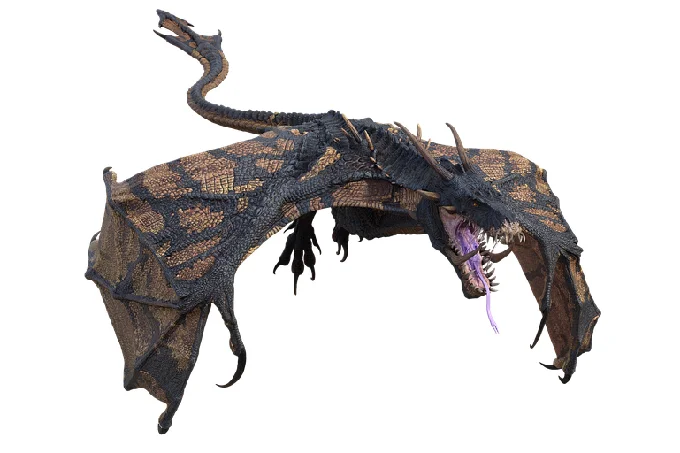
Children all throughout the world like hearing fairy stories about dragons, and ancient Chinese and Japanese rulers even thought they were descended from dragons. Diverse civilizations have different interpretations of dragons. They may be cruel or kind, creators or destructive.
There are legends about benevolent dragons throughout Asia. All they need is respect and great gifts. There are also fire-breathing dragons in Europe that demand human sacrifice. Dragons are often revered in the East and feared in the West.
For a variety of causes, dragons have taken over our minds. They start by spewing flames. These are the only species capable of shooting, or, to put it another way, spitfire. This is only one of the amazing characteristics of these animals from folklore and mythology all throughout the world. Second, some of them have the ability to fly.
Dragons have stayed only in fairy tales in a world where everything seems to have been examined and recorded into scientific catalogs and registers. We know very little about them, so all we can do is study through old documents, gather folk legends, or accept the claims of individuals who claim to have encountered them in person.
Apalala Dragon
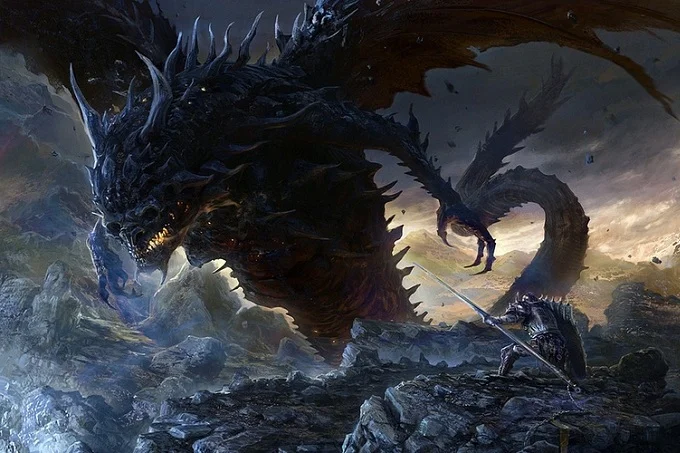
Apalala is a formidable Naga (divine snake), a water dragon that controls rainfall and rivers in Hindu mythology. Apalala is a smart and crafty dragon who has prevented bad dragons from causing devastating floods and downpours. The people of those locations owed the dragon thanks for its protection and plentiful crops.
Every year, the peasants worshipped Apalala by bringing him grain as a tribute. Some residents, however, ceased paying their yearly homage to Apalala after many years without terrible floods. This disdain infuriated Apalala, who transformed into a fearsome dragon. With tremendous rains and floods, he started to terrify people and ruin the whole harvest.
Boom arrived in Apalala one day and felt sorry for the peasants whose crops had been damaged by an angry dragon. Apalala was spoken to by the Buddha, who persuaded him not to deliver floods to these areas. Apalala relished the euphoria and vowed to never be so hateful again. He only requested a single harvest every 12 years. As a result, it rains severely on the soil every twelfth year, and Apalala gets a rain-soaked crop as a gift.
After embracing boomism, Apalala produced as much rain as was required each year to produce a bountiful crop. The location of Apalala determined the well-being of all the villagers.
Wyvern Dragon
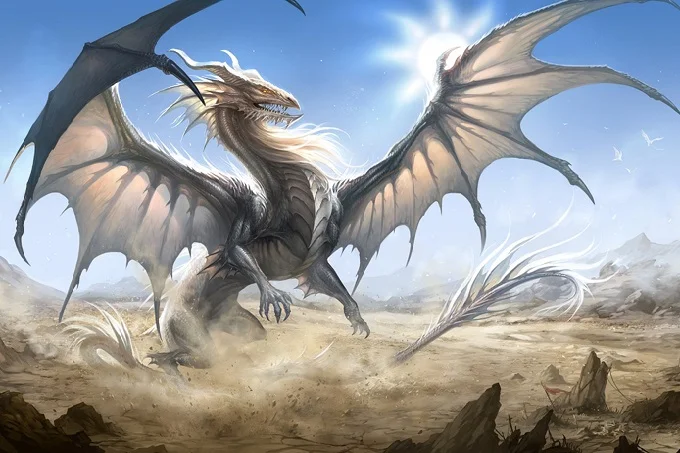
Wyvern is a legendary European dragon from the Middle Ages (mainly Scandinavian countries, Germany, England, and France). This is one of the cruelest beasts, with fetid and scorching breath all around it, as well as terrifying teeth. It ruins whole communities and strangles victims in the rings of its serpentine scaly tail with spikes.
Despite its massive size, it moves quickly in the air and is nearly impenetrable to arrows. When attacked from the air, it erupts in flames and kills with a single flick of its leathery wings, which are each shaped like a ship’s sail. A Wyvern may only be killed by wounding it in one of two susceptible spots: the base of the tail or the open mouth.
The riches guarded by the Wyvern drew many explorers. The monstrous beast had a vast gold, silver, and precious stone hoard. He had amassed it during his long existence, causing terror and ruin.
Many greedy treasure seekers dreamt of capturing the wealth, but in the Wyvern’s lair, all they found was death. The hero must be extraordinarily strong, bold, and fortunate in order to slay the Wyvern and gain glory. The battle-weary hero could only exult at the prey when he was satisfied that the dragon was killed.
Beowulf Dragon
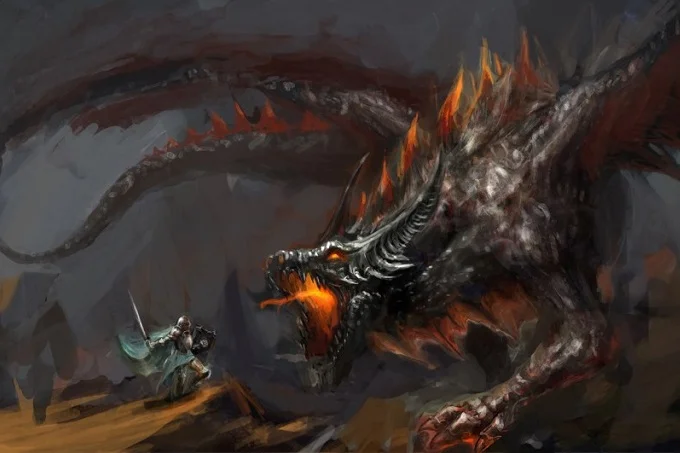
A terrifying dragon, a fire-breathing beast fifteen meters long, coiled into rings, in the area of Heorot in southern Sweden, in a cave under a gray rock. The dragon defends its cave, which is brimming with rare relics.
He shields them from the sun’s rays, which should not shine on the gold and silver utensils, valuable stones, pearls, and gold coins hidden deep inside the cave.
When a thief takes a golden goblet from the dragon’s cave, he becomes enraged and flies about the region, scorching everything in his path. The dragon spits flames into the sky, scaring locals and setting fire to buildings and crops in Gauteng.
Beowulf, the Gouts’ king, led an army to combat the dragon, equipped with a magical sword. Beowulf slashed the dragon with his sword, but the blade slipped over the monster’s thick skin. Beowulf was enveloped in flames from the dragon’s jaws, and it looked so bad that his army left the battlefield.
Only the master’s trusty servant Wiglaf remained. Beowulf slashed the dragon’s head with the blade of his magical sword. Beowulf was bitten in the neck by the dragon, yet despite the fact that he was bleeding, he continued to battle. Beowulf chopped the dragon in two after Wiglaf injured it at a weak area. The horrible dragon’s life came to an end in this way. However, Beowulf died of his wounds after the fight, and the dragon’s spoils were brought out of the cave and buried beside Beowulf. The body of the dragon was dismembered and thrown into the sea.
Wawel Dragon
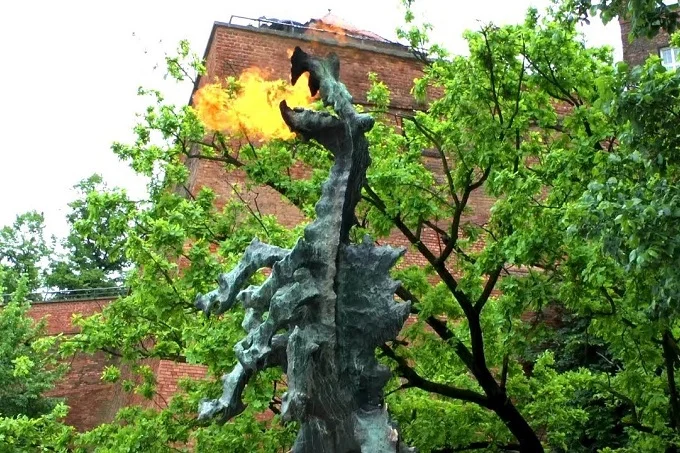
A terrifying dragon resided in a dark cave at the foot of Wawel Hill on the banks of the Vistula River, according to Polish folklore. Every day, he soared about the area, terrifying the city’s residents. Animals and humans were consumed by the fire-breathing dragon. Anyone who got in his path became his target right away.
Even tiny children he encountered were eaten by the dragon, who also plundered homes and brought riches to his lair. Many courageous knights attempted to slay the dragon but perished in the flames. Daily dragon raids have become a complete mess. The monarch pledged half of the country to whoever defeated the dragon, and the people in these districts got impoverished by the day.
According to the most ancient version of this mythology (12th century), a certain Krak despatched his two sons, Krak and Lech, to slay the dragon in order to preserve the city from the monster. The sons were unable to vanquish the serpent in a duel, so they devised a plan. They packed a cow’s skin with sulfur, and the dragon drowned after swallowing the stuffed animal.
Following the monster’s demise, the brothers fought about who was responsible for the triumph. When one of the brothers returned to the castle, he murdered the other and said that the second brother had died in combat with the dragon. The mystery of the fratricide was discovered after Krak’s death, and he was exiled from the nation.
In his chronicle, Jan Dlugosz (born in the early 15th century) ascribed the triumph over the dragon to the king himself, and suffered fratricide after Krak had already dead.
According to Joachim Belsky’s version of the narrative (16th century), the dragon was vanquished by the shoemaker Scuba. He threw a sulfur-filled cow to the beast. The dragon that ate the calf started to burn in his throat and drank half of the Vistula before bursting.
Saint George and Dragon

A violent dragon dwelt near a spring in the Libyan city of Cyrene, according to a mythology that arose in Europe in the sixteenth century. Some daredevils attempted but failed to murder him. The people of Cyrene were obligated to deliver him two lambs every day in order for him to get water without being hindered. The dragon then requested that young females be fed to him.
People drew lots every day, and the next victim went to the dragon with a shriek. The king’s daughter was drawn on the twelfth day, and her father was devastated. He offered the villagers all of his wealth and half of the country in exchange for his daughter’s life, but they declined.
The princess was tethered to a spring near a post. Then, out of nowhere, a young warrior named George emerged and rescued her from her enslavement. Saint George raced to the dragon’s aid, riding a horse. His spear pierced the monster’s body, yet it did not kill him; instead, it simply injured him.
Saint George escorted the injured dragon into the city while wearing a princess sash. He told the locals that he would only put an end to the dragon if they accepted Christianity. Saint George sliced the dragon into a thousand pieces once the citizens of the city consented. They started to refer to him as the Victorious because of his triumph against the dreadful snake.
Zmei Gorynych Dragon

Three fire-breathing heads and seven tails characterize this fierce dragon from Russian epics and fairy tales. Gorynych is a snake that travels on two legs, with two little front legs, similar to a tyrannosaurus. Any shield or armor may be ripped apart by its iron claws. The presence of sulfur in the air surrounding Serpent Gorynych indicates that he is malevolent.
He once kidnapped Zabava Putyatishna, Prince Vladimir Kyiv’s niece, and imprisoned her in one of the twelve caverns he dug in a high mountain. The prince, bereft of hope, offered a large payment to anybody who could rescue the girl. No one wanted to combat the monster, so Prince Vladimir sent the hero Dobryna Nikitich to the battleground.
After a three-day and three-night battle, the Serpent started to overtake Dobrynya. Here, the hero recalled his mother’s magical seven-tailed whip, seized it, and let the Snake lash him between the ears. Dobrynya pushed Gorynych to the ground with his left hand and thrashed him with his right hand as the snake Gorynych dropped to his knees.
He tamed him and cut off all three heads before heading out to find Zabava Putyatishna. He released several prisoners from eleven caverns, including Zabava Putyatishna, who was tied to the wall with gold chains in the twelfth. To get access to the cave’s free light, the hero and the maiden tore off the shackles.
The Serpent Gorynych produced many children, including snakes that resided “in an open field” and were stomped by an epic hero’s horse. The Serpent Gorynych is related to the Serpent Tugarin and the Fiery Serpent, both of which are wicked and fire-breathing figures from Russian folklore.
Other stories about the Serpent Gorynych may be found in Russian mythology. In one of the stories, the Serpent Gorynych serves the merchant’s son Ivan, then murders Ivan with the help of his wife, but dies himself.
Knucker Dragon
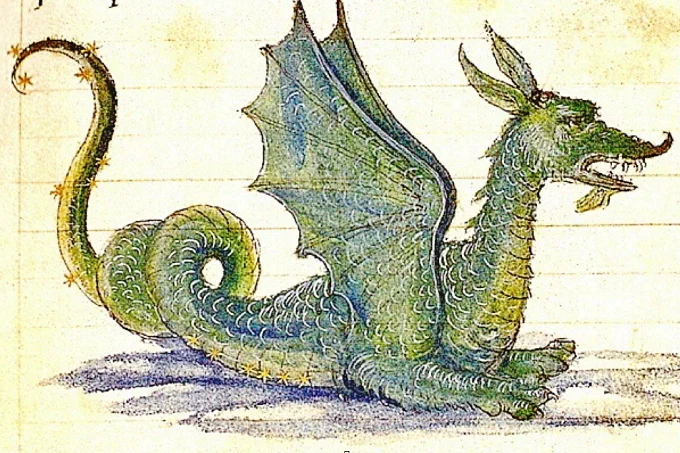
Knucker was a terrifying dragon that resided in Lyminster, West Sussex, England, in a water hole. He flew to the Leominster fields late at night in quest of sustenance. He was a horse and cow thief. Anyone who stepped in the path of the knucker became a victim as well.
The dragon suffocated or tore its victim apart with its venomous teeth. The blasts of the knucker’s massive tail ripped the trees off Westward Park. The hiss and roar of a ravenous dragon disturbed the night’s calm in Leominster.
Because so many people and animals have vanished in the neighborhood, the mayor has given a prize to anybody who can kill a Knucker and put people out of their misery. Jim, a farm child, informed the mayor of his plan to slay the monster. The villagers were commanded by the Mayor of Leominster to furnish Jim with anything he required.
The locals collected ingredients for a large cake for Jim. Jim made a huge pie for the knucker and loaded it with poison. He drove the cake to the dragon’s lair by borrowing a horse and wagon. Knucker died after eating the cake with his horse and wagon. After then, Jim used an ax to slice off the dreadful dragon’s head.
The Knucker Jim shot was most likely the last of its type. Many knuckers previously resided in West Sussex, according to folklore, on Bignor Hill and in the woodland of St. Leonard.
People gathered to the last Knucker’s aquatic lair after his death and attempted to determine the depth of the hole. They dropped six bell-ropes into the sea after tying them together. The ropes were not long enough to reach the bottom, and the ropes did not reach the bottom. The water from the Knucker hole was then utilized as healing water by the locals.
We’re probably talking about a tiny lake with a circumference of less than a kilometer that was fed by underwater sources since no streams or rivers flowed into it. In English, the Knucker’s pit is known as “knuckerholes”.
Nidhogg Dragon

Nidhogg is a powerful dragon who appears in Germanic and Scandinavian mythology. He is a resident of Niflheim or Helheim, the realm of evil. The name of the dragon translates to “corpse ripper”. Nidhogg consumes the souls of those who pass away in the underworld.
The dragon is said to suck the blood of sinners such as liars, perjurers, and murderers. These repulsive creatures take up residence in Niflheim. The ninth planet of the dead is the darkest, coldest, and lowest of the nine worlds.
Near Hvergelmir, there is a pit inhabited with poisonous snakes known as House Nidhogg (Boiling Cauldron). This is the stream that feeds all of the world’s rivers.
Nidhogg gnawed at the base of the Yggdrasil tree — a great ash tree that links heaven, earth, and the underworld – with the assistance of four snakes, causing a conflict between gods and monstrous monsters.
The gods won the epic battle of Ragnarok after a horrific three-year winter. Nidhogg took part in the fight but was not slain. He made it back to the domain of darkness, where he feasted on the remains of those who were thrown to him from the battlefield.
Orochi Dragon

Every year, the ferocious Japanese dragon Orochi demanded the sacrifice of a young girl. Even the most valiant soldiers couldn’t defeat the terrible and cunning monster. His colossal bulk encompassed eight hills and valleys, and his eight heads prevented anybody from approaching him.
Susanoo, the deity of the sea and storms, came upon a wailing man and woman one day. Orochi has devoured seven of their daughters in the last seven years. They only had one daughter left, and she was about to be sacrificed to Orochi. Susanoo volunteered to destroy the dragon in exchange for the marriage of their seventh daughter.
Susanoo transformed the young lady into a comb, which he stowed away in his hair. Then he formed a circle with eight massive vats of rice vodka. Orochi dipped all eight of his heads into the vats, attracted by the powerful drink’s aroma, and drank enthusiastically.
The intoxicated dragon then collapsed to the ground and passed out. Susanoo then pulled his sword and slashed Orochi’s heads off. The blood of the killed creature had stained the water in the neighboring river.
Ryujin Dragon
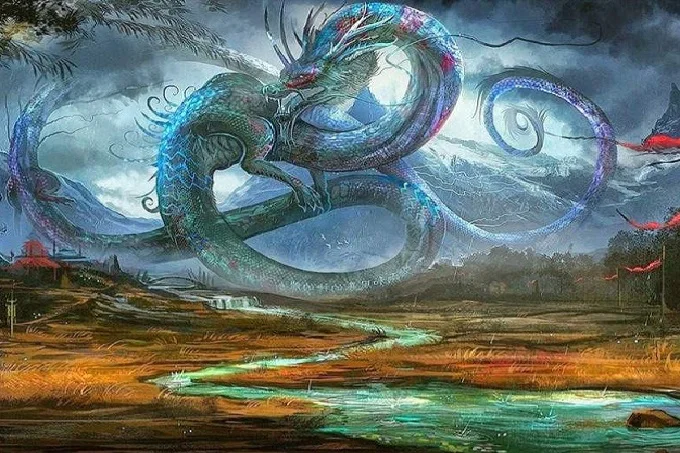
The dragon Ryujin is the deity of the sea and the master of the water element in Japanese mythology. He dwells in a castle made of red and white coral and studded with valuable stones at the ocean’s bottom. His castle features a white winter hall, a cherry-tree-filled spring hall, chirping cricket-filled summer hall, and brilliant maple-tree-filled autumn hall.
One day in Ryjin’s underwater palace is equivalent to hundreds of years on Earth for a human. Sea turtles, fish, and jellyfish are loyal slaves of the dragon deity. Ryjin uses a mystical jewel to control the tides.
People should approach him with care, since no mortal can bear the sight of his complete body. A storm blows out at sea when Ryjin gets enraged, killing the sailors.
Empress Jingu requested Ryjin’s assistance when she decided to attack Korea. Ebb and flow were two stones delivered to her by the dragon’s messenger. Jingu was in charge of the Japanese navy’s trip to Korea. Korean warships intercepted them at sea. The Korean ships went aground when Jingu hurled a casting stone into the ocean.
Jingu tossed a tidal stone on the seabed as the Korean warriors leaped from the ships to fight on foot. The whole amount of water flowed back and drowned the opponents.
Fuzanglong Dragon
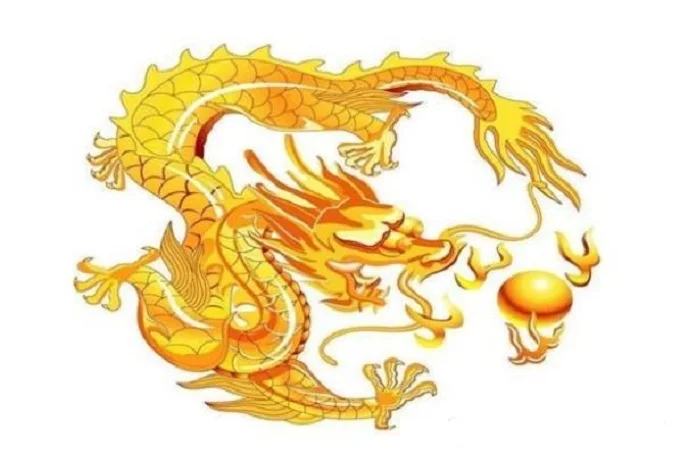
The Chinese Fuzanglong is a dragon that lives deep down and guards secret riches. He preserves all valuable stones and metals in his cave. Fuzanglong has a magical pearl in his mouth or around his neck. Because pearls represent intelligence, they are considered the dragon’s most valuable possession. Fuzanglong grew to its massive size over the course of three thousand years.
The freshly born dragon had the appearance of an eel. Fuzanlong’s head resembled that of a carp five hundred years later. The dragon has grown a lengthy tail, a thick beard on its head, and four short clawed legs at the age of one and a half thousand years. Fuzanglong had developed horns by his two thousandth birthday.
A residential complex was developed near the mountain where, according to mythology, Futsanlong resides in Hong Kong (Xianggang). To avoid obstructing Fuzanglong’s view of the ocean and keep its favorable position, the architects left an open area in the center of the complex.
Fucanglong, like other Chinese dragons, is benevolent until he becomes furious. It must be handled with respect in order for the dragon to not become stubborn. Volcanoes erupt as Fucanglong lifts off into the sky.
Hatuibwari Dragon

There is an old belief on the island of San Cristobal in Melanesia that the chief spirit, the dragon Hatuibwari (also known as Agunua), created and nourished all living creatures. His body is half-human, half-serpentine. He flies over the skies on two huge wings, and his four eyes let him view everything on the surface and underneath.
Hatuibwari once used his hands to mix crimson clay, breathed on it, and blinded a human figure. He placed the clay sculpture in the sun, and it sprang to life, revealing the first lady. When the first lady fell asleep, Hatuibwari extracted a rib from her, mixed it with clay, and made the first man.
Hatuibwari once wrapped himself over his human grandson to comfort and soothe him. When the child’s father got home, he thought his kid was being strangled by a big snake. Hatuibwari was chopped to bits with a knife by the terrified man, who didn’t recognize the dragon as his father-in-law. The dragon’s bodily pieces, on the other hand, were reconnected.
Hatuibwari, enraged and outraged, declared that he would leave the island and destroy the entire crop. Hatuibwari moved to the island of Guadalcanal, and everything in San Cristobal fell into disarray while he was gone.
Shenlong Dragon
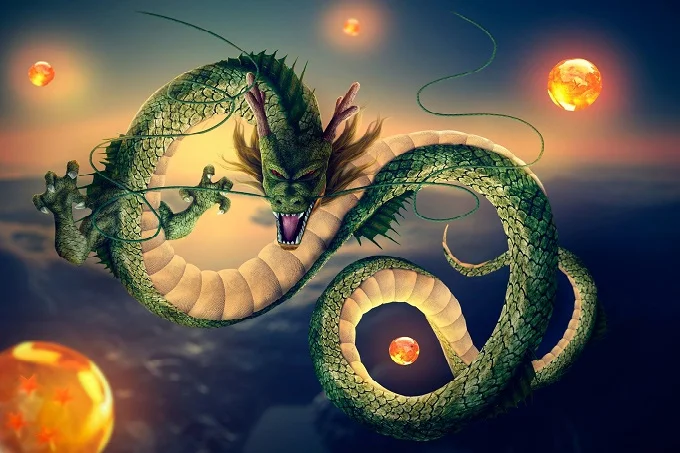
Shenlong is a celestial dragon in China who is in charge of the weather. He has complete power over the weather, including rain, clouds, and wind, which is crucial in a nation where agriculture is the major source of income. A plentiful harvest needs a lot of rain. The dragon must be revered and handled with respect.
It is critical not to insult Shenlong, since he will get enraged if he feels ignored. Then he sends horrible weather, such as floods or droughts, to ruin the crops that China relies on for survival. Shenlong feels fatigued and retires from time to time. To hide and not work, it shrinks down to the size of a mouse. If a home or a tree is struck by lightning, the thunder god sends a servant to find Shenlong.
Shenlong became so large as he soared into the sky that he could not be comprehended by the sight. He is a generous man who is also angry. Shenlong brought the worst floods in Chinese history after being mistreated by humans.




